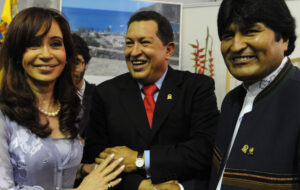
It took 20 years to defeat Evo Morales’s Movement Toward Socialism (MAS) in Bolivia through elections. Two decades of political battle lines, along with a so-called “cultural war,” run deep in the region. MAS rose to power thanks to the financing it received from Hugo Chávez, who, using the vast pockets of Venezuela’s oil rents, injected money into campaigns across almost every country in the continent. For a long stretch, he and his allies virtually took control of South America — except for Colombia.
The Venezuelan crisis left them exposed, however. Not only did the money used to fund political campaigns run out, but the tragic example of Chávez and Maduro’s socialism — driving more than nine million people to flee their country in search of better living conditions — became the starkest warning of the chaos caused by a system in which the State regulates and controls the economy at the same time.
On August 17, it wasn’t just that the left lost power in Bolivia. What was most shocking was the crushing manner in which it happened. Beyond local factors, an unexpected external influence also played a role: Javier Milei’s rise in Argentina.
The Electoral Collapse of the Socialist Option
The name of Bolivia’s next president is still unknown; Opposition figures Rodrigo Paz and Tuto Quiroga advanced to the runoff scheduled for October 19. The ruling MAS, by contrast, suffered a historic defeat: its candidate failed to reach 4 percent of the vote, and in the legislature, socialists saw their representation slashed from 75 seats to just one. This collapse was also fueled by internal divisions.
Evo Morales, the party’s historic leader, had initially backed Luis Arce. Once in office, though, Arce began to distance himself from Morales, partly due to Morales’ interference in government decisions and partly because of ephebophilia allegations against him — charges for which he was ultimately convicted, though he remains free, protected by what he calls his “indigenous praetorian guard.”
But politics alone can’t explain MAS’s downfall. Bolivia was experiencing one of its worst economic crises in decades. Many factors contributed, including:
- Collapse of the energy sector: Gas production, the country’s main revenue source, plummeted from 60 million cubic meters per day in 2014–2015 to just 28 million in 2025. Mismanagement and lack of maintenance slashed exports and so, foreign trade.
- Depleted reserves: In 2014, Bolivia held $15 billion in international reserves, but by 2025 that figure had dropped to under $2 billion. This left the government unable to maintain subsidies or import fuel normally.
- Shortages of diesel and gasoline: 66 percent of stations stopped selling diesel and 38 percent stopped selling gasoline. In many cities, lines stretched over 11 hours. The crisis hit agriculture and transportation so severely that the government authorized payments in cryptocurrency to import fuel.
- Food crisis and inflation: Prices of staples such as rice, meat, and fish rose as much as 58 percent in a single year. Annual inflation reached 23 percent in June 2025, with food inflation hovering between 17–24 percent.
- Widespread poverty: According to the World Bank, over 35 percent of Bolivians now live in poverty, with extreme poverty around 11 percent. Many households cut back from three meals a day to just one.
- Debt and fiscal deficit: Public debt hit 95 percent of GDP at the end of 2024, while the fiscal deficit surpassed seven percent of GDP, leaving no fiscal margin.
Ordinary Bolivians felt this collapse firsthand: endless gas station lines, skyrocketing food prices, and the impossibility of accessing dollars as their local currencies became worthless. That combination eroded whatever support MAS still had left.
The Milei Factor
Meanwhile, next door in Argentina — a country that had faced a similar crisis years earlier — a wild-haired libertarian was steering the nation onto a new course. He had campaigned with a chainsaw as his symbol, vowing to slash public spending, government payrolls, and state control of the economy, all while shouting, “Long live freedom, damn it!”
At first, few took him seriously. But within two years, he became an international phenomenon. Milei won the presidency against all odds and began implementing exactly what he promised by shrinking the state and freeing the economy.
Milei inherited Argentina with 211.4 percent annual inflation in December 2023. By May 2025, the consumer price index rose only 1.5 percent — the lowest in five years. Poverty fell from 52.9 percent to 38.1 percent. A country once seen as doomed to hyperinflation and misery began to rapidly recover.
Bolivians took notice. Both Rodrigo Paz and Tuto Quiroga — the candidates who made it to the runoff — have pledged to cut public spending and reduce the size of the state. This shift has already become a regional trend.
The Rightward Turn in Latin America
Before MAS’s defeat in Bolivia, Ecuador had elected Daniel Noboa, a president closer to the United States and more distant from the region’s socialist regimes. Around the same time, Argentina’s Javier Milei had secured his own victory. Now it’s Bolivia. Step by step, the political map of the region is shifting.
In the coming months, presidential elections will take place in Chile and Honduras — both governed by the left. Polls in both countries currently show center-right candidates with strong chances of victory. These candidates openly reject socialism, criticize excessive state intervention, denounce the brutality of Cuba, Venezuela, and Nicaragua, and advocate for strategic partnerships with the United States rather than China, Russia, or Iran.
Not all of them can be described as “libertarians” or as followers of Hayek’s economic thought, like Milei. But they are far removed from the region’s recent enmeshment in statism, repression, and narcotrafficking cartels. They also appear willing to cooperate with Washington on regional security, migration, and economic matters.
What’s remarkable is how the Argentine phenomenon has shifted the regional dynamic.
In a Latin America long accustomed to government handouts, presidential candidates no longer compete to offer more subsidies and social programs. They now compete to promise deeper cuts, less government, and greater individual freedoms.
The cry of “Long live freedom, damn it!” began in Buenos Aires, echoed in La Paz, and the rest of Latin America now awaits its turn at the ballot box, to join the libertarian wave that seems to be reshaping the continent’s political landscape.
